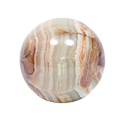
An August birthstone, the sardonyx gemstone, combines alternating layers of sard and onyx—two types of the layered mineral chalcedony—to create a reddish zebra-striped gemstone with white bands.
Its name, similarly, combines sard (referencing the ancient Persian city, Sardis—in present-day Turkey—where the red stone was found) with onyx (from the Greek word of the same spelling, which meant “nail or claw.”)
Sard ranges in color from yellowish-red to reddish-brown, depending on how much iron oxide is present. Sard is easily confused with carnelian, another type of chalcedony that is slightly softer and lighter in color. The deep red, brown, and yellow color of this stone makes sardonyx jewelry stand out.
Sardonyx, like onyx, shows layers of parallel bands instead of the chaotic, curved bands that compose agate, another type of chalcedony.
The finest examples of sardonyx, which display sharp contrasts between layers, are found in India. Other sources include Brazil, Germany, Czech Republic, Slovakia, Madagascar, Uruguay, and the United States.
Measuring 6.5 on the Mohs hardness scale, sardonyx is widely available and relatively inexpensive as gems, beads, and jewelry. It is often carved into cameos, intaglios, and brooches to show the color contrast between layers.
Copyright © 2025 American Gem Society